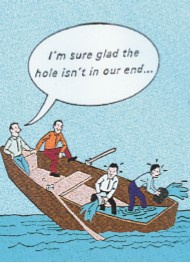CM Perspective: Team + Communication = Success
CM Perspective: Team + Communication = Success

Shirley Franklin is general manager of Foxworth-Galbraith Truss Co. in Yuma, Arizona.
Communication is always key in relationships, on a team, and especially when running a business where both team and relationships are the foundation. The better you and your team are at communicating, the better your product and productivity will be. Our secret to success at Foxworth Galbraith is constant communication between sales, management, production, shipping, design, and our customers.
Each week we have a meeting with our management team and our sales representatives to make sure we are all on the same page. The reason for this is we know our sales representatives are the faces of our company to the outside world; to our customers. It is very important that our sales representatives are relaying feedback from our customers to the management of each department and that everyone is working together as one unit to improve our process as a whole.
At this meeting we go over the schedule for the upcoming week and discuss current issues and developments we learned from the week before. Unfortunately, these type of meetings can easily turn into the blame game. In order for these meetings to be productive, we have to view ourselves as if we are all on the same boat. If there is a hole, we all need to be bailing water, regardless of who made the hole. Otherwise, we will all sink. This is the mentality that all of our employees must have. Once we have patched the hole by fixing the issue, then the accountability piece comes in. This is where we explore what went wrong, and how we can make sure it doesn’t happen again. This is the opportunity for the team to learn from their mistakes.

I keep this picture in my office and I use it often. Anytime someone comes to me playing the blame game I point to the picture. It is so important for our team to remember that we are all in the same boat. If design fails we all fail. If production fails, we all fail. If sales, or shipping, or management fails, all our customer sees is that we didn’t delivered what we said, when we said we would, with the service we promised.
There are two things that all component manufacturers can do to help their employees and their company succeed through improved communication. The first is process. Processes are created to ensure that things are done correctly and uniformly. Processes are what you teach
Shirley Franklin is general manager of Foxworth-Galbraith Truss Co. in Yuma, Arizona. Team + Communication = Success
new employees when they start a job at your company. The processes that your company has put into place need to be followed and revisited often.
For instance, one part of our process is that all requests must be sent in an email or text message. If a designer needs an RFI answered, or if a sales representative needs a job rushed through production, they must put it in writing and ensure it is sent to all necessary departments. This is an accountability piece. If all employees follow this process, all the necessary departments are responsible for helping reach this goal or fulfilling the request. This communication ensures that everyone is on the same page and can be held accountable. Even if the request starts through verbal communication, it is important that it is followed up with an email or text. This is something that we constantly revisit to make sure that all departments are working as one unit.
The second thing that all CMs can do is encourage their employees to communicate when there is a breakdown in the process. Instead of management trying to fix the process or getting rid of a person because they aren’t “doing their job,” explore first why the process is failing. I don’t think anyone comes to work to fail. People, for the most part, want to do well, they want to succeed. People want to be able to go home and tell their family and friends about their day and feel good about what they have accomplished.
Usually, when an employee fails there is an obstacle in their way or the training they have received was not properly introduced. Do they need to be better trained on what to do and how to do it? Is there a problem with the process you have set in place? I have found that most often the employee can tell you exactly what they need to succeed. Once you have the employee’s solution, as long as it is within reason, try implementing it to see how it works. It is important to note that the employee who has given you the solution has skin in the game and they are the ones who will have to work with the new process. The reason I point this out is the employee cares and wants the company and themselves to succeed just as much as the rest of the team.
The new process may not be perfect or fool proof, and you may have to make tweaks as you go along, but the process will improve and the same mistakes and hurdles will not continue to be an issue.
Being able to communicate your process well and allowing your employees to communicate what their needs are will enable your departments to work together as one unit with the same goals. If you can improve communication throughout your company, it will improve your product, your customer service, your company culture, and your success as a whole.

